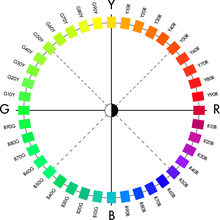Natural Color System
The Natural Color System ( NCS ) is a standardized color system which, according to the manufacturer, the Scandinavian Färginstitutet AB, should reflect the human color perception . The color space that can be represented is controversial, the NCS system is essentially implemented using the cataloged color tones.
history
Based on the theory of opposing colors ( opponent theory ) by Ewald Hering , the Swedish physicist Tryggve Johansson developed a color model between 1937 and 1939, which became the basis for a color atlas by Sven Hesselgren with around 500 colors. This color atlas was extended by Anders Hård to the Natural Color System (NCS) with 1750 colors. In 1995 the system was expanded to include 1950 colors in the “Second Edition”.
In 1946, Anders Hård founded Skandinavisk Färginstitut AB ( Scandinavian Color Institute ) in Stockholm, which publishes the NCS system and administers the rights.
NCS color theory
The Natural Color System is based on four colorful primary colors from the color proficient in a survey people as "pure", and therefore free from any color cast were conceived. A "pure" blue is perceived as free from yellow or a green free from red. These pairs of colors are arranged opposite one another in a color wheel and their abbreviations Y (ellow), G (reen), R (ed), B (lue) form the Basis of the system. All other color shades are seen as intermediate levels between Y / G / R / B and their distance from them is given in percentages. Another factor is the brightness component, the expression towards black or white.
The saturated colors form on a color wheel , which is at the same time the base for a double cone tapering upwards (pure white) and downwards (pure black). Similar to other color models, such as the Ostwaldschen . On the outer surface of the upper cone are the colors that, according to the NCS definition, are created by tinting with white. The colors created by tinting with black are arranged on the outer surface of the lower cone. If a plane is cut out of the double cone along the white-black axis, according to the NCS theory, an area of the same color is obtained, with "black" colors along the upper edge (= colors with the same proportion of black), along the lower edge " white-like "colors and along the black-white axis the" pure "colors should be able to be read, that is, those colors with the same proportion of white or the same color purity .
The NCS color coding is based on these principles and consists of two parts: the first part shows the black component and the color (color saturation), the second part the position of the basic color on the YGRB color wheel. All numerical values are between the maximum value 100 and 0 as the minimum value. Colors that could not be produced with the pigments used are not available in the NCS color fans.
example
- A 30% saturated yellow tending to slightly reddish (30% red) with a 30% black component is designated in the NCS system with NCS 3030 - Y30R .
Color shades that are directly on the gray axis are given an N for neutral instead of the color name, NCS 5000-N is medium gray.
A preceding S (in the above example NCS S 3030 - Y30R ) means that the corresponding color value comes from the Second Edition , i.e. the revision of the 1995 catalog.
Meaning and discussion
The NCS system is one of the color systems in which a larger number of color tones (in 2016 it was 1950) are available in a systematically organized form and are used in building colors. Several color manufacturers convert the NCS notation directly into color tones or use it as a basis for their systems. Due to the empirical (not mathematical) approach, NCS color tones cannot be converted into L * a * b * , RGB or CMYK color values using an algorithm , which greatly limits the universal usability of the system. Due to the concept of copyright and protection of the Scandinavian Färginstut, there are also no generally available free RGB, Lab, CMYK color tables. With the “Navigator Premium”, NCS only offers a paid software solution.
The NCS model does not consistently meet its own claim to reflect Hering's opposite color theory in geometric form. In the perception of a normal observer, the underlying NCS color pairs “R / G” and “B / Y” do not form any complementary successive contrasts. Rather, these are included
- R <> B50G (mint green)
- B <> Y60R (orange tone)
- G <> R30B (purple tone)
- Y <> R60B (blue)
These pairs are not opposite each other in the NCS color wheel. The empirical approach on which the model is based has not been precisely documented. According to the NCS, around 30 respondents formed the observer base and their individual results remain open, so that a predictable significance or validity is no longer accessible. The survey took place in Sweden in the 1930s, and the measurement possibilities have improved since then. For practical reasons, the model has not been changed since then.
NCS sets the brightness of all basic colors to the same level, which does not match our color perception, because, for example, a pure blue is perceived as darker than a pure yellow. This consideration has been implemented for the CIEL * a * b * color space , for example .
Web links
- NCS - International Page (Scandinavian Color Institute)
- NCS - German language site (Alexandra Fellner Color Communication, Vienna)
- NCS - German language website (NCS Berlin)
- NCS - German language site (NCS Switzerland)
Individual evidence
- ^ The NCS (Natural Color System) , accessed April 23, 2009.



